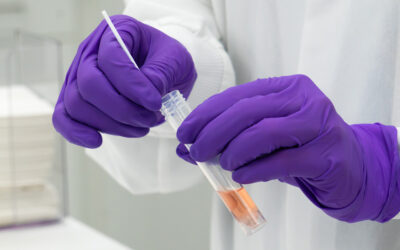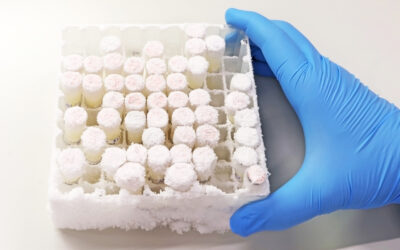Photo: Drug-resistant Mycobacterium tuberculosis (Source: CDC)
The largest recent outbreak of multidrug-resistant tuberculosis (MDR-TB) in the United States is currently unfolding in the Minnesota Hmong community. Many Hmong elders were resettled in the Twin Cities years ago after living in a Thai refugee camp where TB was common. Health officials believe one of the reasons the disease spread among the elders is the long hours they spent together playing card games. Pulmonary TB can be spread by coughing, sneezing, talking or singing. A person is more likely to become infected with TB if he or she spends time in poorly ventilated, overcrowded environments with an infected person. Sadly, the outbreak has claimed six lives as of early November, and the Minnesota Department of Health says they will be dealing with the outbreak for several years because the disease is difficult to detect.1
Antibiotics have effectively treated TB since the 1940s, but the spread of drug-resistant TB strains is a serious threat to global health. As the case in Minnesota demonstrates, the disease can lie in wait for years, only becoming active when the infected person’s immune system is weakened. To help spread the word about drug-resistant TB and World Antibiotic Awareness Week, we’ve compiled interesting, sometimes strange, facts about the disease.
1. TB has deep roots
Tuberculosis, TB, consumption, phthisis, Pott’s disease, scrofula, yakshma, chaky oncay, romantic disease, the White Plague.2 This disease, caused by strains of Mycobacterium tuberculosis, has been known by many names over its long and legendary history. The oldest evidence of TB dates back approximately 9000 years. Lesions typical to TB were found on human remains taken from the now submerged Neolithic village, Atlit-Yam, in the Eastern Mediterranean.3 References to TB (yakshma) are found in the Vedas, sacred Hindu scriptures originating from the ancient Indian subcontinent, dating back to 1500 BC.4
2. TB was romanticized
Lord Byron, a poet and leading figure in the Romantic movement, reportedly said, “I should like to die of consumption…because all the women would say ‘See that poor Byron – how interesting he looks in dying.’” During the nineteenth century, TB was known as the White Plague or the white death due to suffers’ pallid appearance. To some, the disease represented spiritual purity and temporal wealth, and was considered a “good death” because of its slow progression. Poets and writers of the era wrote romantically about TB leading it to be viewed as a “romantic disease.” The thin, pale and morose characteristics of TB patients were perceived as attractive. Many young, upper-class women purposefully paled their skin to achieve the consumptive appearance.5
3. TB was “cured” by royal touch
During the Middle Ages, it was widely believed that English and French royalty could cure mycobacterial cervical lymphadenitis, a swelling of the lymph glands associated with TB (also known as scrofula), simply through touch. Royal touch was thought to be bestowed on royalty by the divine rights of sovereigns. The frequent practice of royal touch led to scrofula being known as the “King’s Evil.”6

Source: Wikimedia Commons
4. TB helped bring an end to public spitting
When tubercle bacilli were discovered in sputum, the National Association for the Study and Prevention of Tuberculosis (original name of the American Lung Association) launched a campaign to end public spiting. Communities throughout the United States outlawed spitting on streets and the floors of public buildings. Anti-spitting advertisements were posted in newspapers, street signs and bulletin boards, and spittoons became common place in shops, theaters and taverns.7
5. Many historical figures had TB8,9
The lengthy list of famous (and infamous) people who had TB includes:
- King Tutankhamen
- John Keats
- Edgar Allan Poe
- Emily Bronte
- Eleanor Roosevelt
- Adolf Hitler
- Nelson Mandela
- Desmond Tutu
- Tina Turner
- Ringo Star
- Carlos Santana
6. TB is still a global health threat
TB touches every part of the world, but countries with limited resources are most at risk. According to the World Health Organization (WHO), over 95% of cases and deaths are in developing countries (last year we wrote about the battle against TB in Timor-Leste). Approximately one-quarter of the world’s population is infected with latent TB. These people have not become ill and cannot transmit the disease. An infected person has a 5-15% risk of falling ill, but the risk increases dramatically if he or she has a compromised immune system (e.g. HIV infection, advanced age).10
Despite important advances in recent years, drug-susceptible TB and drug-resistant TB still are widespread. TB is the number one infectious disease killer and one of the top 10 causes of death worldwide. According to the CDC, 10.4 million people became ill with TB in 2015 and there were 1.8 million TB-related deaths.11
7. Drug-resistant TB is on the rise
Streptomycin produced by the bacterial strain Streptomyces griseus was isolated in 1943 and was the first effective antibiotic against M. tuberculosis. Strains of TB bacteria have become resistant to treatments ever since through natural defenses and genetic mutations.
There are two types of drug-resistant TB: Multidrug-Resistant TB (MDR-TB) and Extensively Drug-Resistant TB (XDR-TB). MDR-TB is resistant to the most powerful TB drugs: isoniazid and rifampin. XDR-TB is resistant to is isoniazid, rifampin, any fluoroquinolone and at least one of the injectable second-line drugs. Cases of primary MDR-TB, or direct transmission of the disease from an infected person to a non-infected person, make up 75% of cases. When a patient with a drug-susceptible TB infection is not treated properly, he or she can develop acquired MDR-TB.
Approximately 500,000 new cases of drug-resistant TB occur worldwide annually resulting in 150,000 deaths.11 MDR-TB has spread to every country and XDR-TB has been reported in more than 100 countries. Astonishingly, only one in five cases are diagnosed, and only one in ten cases of MDR-TB are cured.12
8. Drug-resistant TB is expensive to treat
Costs of treating TB in the United States range from $18,000 (drug-susceptible TB) to $513,000 (XDR-TB).13 MDR-TB and XDR-TB require second-line TB drugs resulting in added cost and the patient experiencing more side effects.14
9. We can’t rely on the TB vaccination to prevent drug-resistant TB
The TB vaccination, also known as Bacille Calmette-Guérin (BCG), is used in some countries with a high prevalence of TB to prevent severe forms in children (e.g. TB meningitis). BCG is less effective in preventing the most common form of TB in adults, pulmonary TB. According to WHO, BCG is also likely not effective against cases of drug-resistant TB.15
10. We can help stop the spread of drug-resistant TB
Global and local health organizations are working with communities around the world to halt the spread of TB and other drug-resistant bacteria. Here are few things we can do to help:
- If you are being treated for TB, be sure to take your drugs as directed and complete the full course of treatment
- Avoid close contact with known drug-resistant TB patients. Consult your doctor or a local TB clinic if you have been in contact with someone who has drug-resistant TB
- Healthcare providers must properly diagnose, treat and monitor patients
- Expanded rapid testing and detection of drug-resistant TB cases are needed
Follow these links to learn more about what global and local organization are doing to fight drug-resistant TB:
- World Antibiotic Awareness Week – WHO
- CDC and Partners Tackle Drug-Resistant TB in India
- CDC Antibiotic Resistance Solutions Initiative
- Bairo Pite Clinic in Timor-Leste and the Lab’s Role in Fighting TB
Looking for Mycobacterium tuberculosis controls? We can help! Visit our website to find the best format for your lab.
Resources
- https://www.mprnews.org/story/2017/11/06/tuberculosis-cases-linked-to-deaths
- https://books.google.com/books?isbn=9351527670
- https://www.ncbi.nlm.nih.gov/pmc/articles/PMC2565837/
- https://www.ncbi.nlm.nih.gov/pmc/articles/PMC3705655/
- http://jmvh.org/article/history-of-tuberculosis-part-1-phthisis-consumption-and-the-white-plague/
- http://broughttolife.sciencemuseum.org.uk/broughttolife/techniques/kingsevil
- http://exhibits.hsl.virginia.edu/alav/campaigns/
- http://www.dhss.delaware.gov/dph/dpc/tbfamouspeople.html
- http://www.chron.com/entertainment/article/On-World-Tuberculosis-day-15-famous-people-who-7005109.php
- http://www.who.int/mediacentre/factsheets/fs104/en/
- https://www.cdc.gov/tb/statistics/default.htm
- https://www.cdc.gov/drugresistance/mdrtb-india.html
- https://www.cdc.gov/tb/topic/drtb/default.htm
- http://www.who.int/tb/areas-of-work/drug-resistant-tb/xdr-tb-faq/en/
- http://www.who.int/tb/areas-of-work/drug-resistant-tb/xdr-tb-faq/en/






Deadly facts.